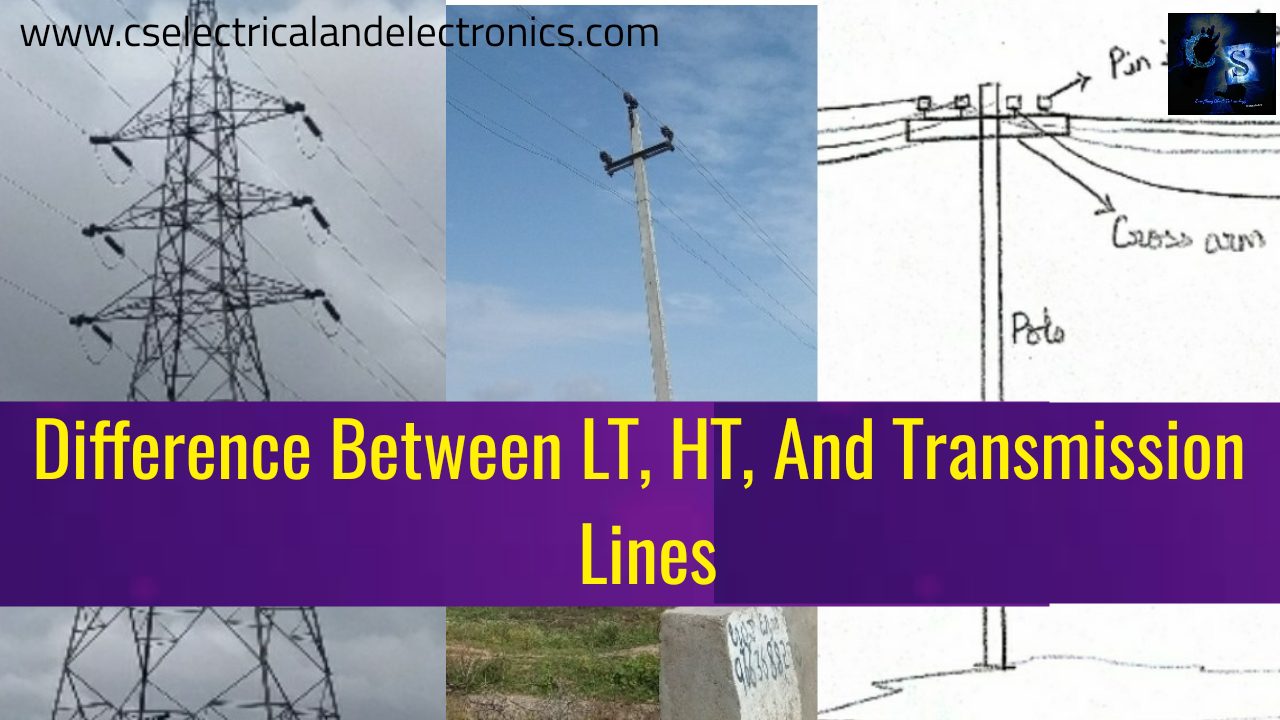Difference Between LT, HT, And Transmission Lines, Conductors Used
Hello guys, welcome back to my blog. In this article, I will discuss the difference between LT, HT, and transmission lines, what is the LT line, what is HT line, what is a transmission line, conductors used in lines, etc.
If you require an article on some other topics then comment us below in the comment box. You can also catch me @ Instagram – Chetan Shidling.
Also, read:
- What is Service Mains, Types, Advantages and Disadvantages
- Types Of House Wiring, Advantages And Disadvantages
- What Is LT Line Or Low Tension Line, Construction Of LT Lines
- Estimation of 11 KV Lines Or HT Line Or High Tension Line
Difference Between LT, HT, And Transmission Lines
What is a LT line?
LT line stands for low tension lines nothing but conductors that carry electricity from the distribution transformer structure to the consumer house.
What is a HT line?
HT line stands for high tension lines nothing but conductors that carry electricity from substation to distribution transformer structure.
What is a transmission line?
Transmission lines are responsible to carry electricity from generating station to the substation.
Now, let’s see the difference between LT, HT, and transmission lines.
01. Full form
- LT line stands for low tension lines.
- HT line stands for high tension lines.
- Tr stands for transmission lines.
02. Voltage
- LT line carries 440 volts voltage(phase to phase) and 230 volts voltage (neutral to phase).
- HT line carries 11 KV voltage.
- The transmission line carries a voltage of 33 KV, 66 KV, 110 KV, 121 KV, 220 KV, 400 KV, 765 KV.
03. Conductors
- In the LT line, four conductors are used such as three conductors for phase and one for neutral.
- In the HT line, three conductors are used for phase (R, Y, B).
- In transmission lines also, three conductors are used for phase (R, Y, B).
04. Insulators
- The types of insulators used in low tension lines are pin insulator and guy insulator.
- Insulators used in high tension lines are pin insulators and disc insulators.
- The insulators used in transmission lines are suspension and strain insulators.
05. Erection
- Low tension lines are erected in every street of the city.
- High tension lines are erected only at main roads.
- Transmission lines are erected outside of the cites.
06. Support structures
- In LT lines, both PCC (plain cement concrete) and RCC(reinforced cement concrete) poles are used.
- In HT lines also PCC and RCC poles are used.
- In transmission lines, steel towers are used.
07. Types of conductors
- In low tension lines, weasel conductor is used for phase and for neutral squirrel conductor is used.
- In high tension lines, the rabbit conductor is used for phase.
- In Tr lines, ACSR coyote conductor is used for 66 KV lines, ACSR lynx conductor is used for 110 KV lines, drake conductor is used for 220 KV lines
08. Size of conductors
The ACSR conductor is made up of aluminum and steel strands.
- In LT lines, the size of the weasel conductor for phase is 6/1/2.59 mm and the size of the squirrel conductor for neutral is 6/1/2.11 mm.
- In HT lines, the size of the rabbit conductor is 6/1/3.35 mm.
- In Tr lines, the size of the coyote conductor for 66 KV lines is 30/2.54 mm (aluminum strands) and 7/1.9 mm (steel strands), the size of the lynx conductor for 110 KV is 30/7/2.79 mm, and the size of drake conductor for 220 KV is 30/7/4.27 mm.
In low tension line there will be 6 aluminum strands and 1 steel strands for diameter 2.69 mm and same for high tension and transmission lines.
09. Bundle conductors
The bundle conductor is made up of two or more conductors which are separated by separators.
- In the LT line, the bundle conductor is not used.
- In HT lines also bundle conductor is not used,
- But in transmission lines, bundle conductors are used, if the voltage more then 220 KV then bundle conductors are used.
10. Cost
- The erection cost of the low tension line is less than the HT line and transmission line.
- The erection cost of high tension line is less than transmission lines.
- The erection cost of Tr lines is more than LT and HT lines.
These are the difference between LT, HT, and transmission lines. I hope this article may help you all a lot. Thank you for reading.
Also, read:
- 10 Tips To Maintain Battery For Long Life, Battery Maintainance
- 10 Tips To Save Electricity Bills, Save Money By Saving Electricity
- 100 (AI) Artificial Intelligence Applications In The Automotive Industry
- 100 + Electrical Engineering Projects For Students, Engineers
- 1000+ Automotive Interview Questions With Answers
- 1000+ Control System Quiz, Top MCQ On Control System
- 1000+ Electrical Machines Quiz, Top MCQs On Electrical Machines
- 1000+ MATLAB Simulink Projects For MTech, Engineering Students
- 2024 Is About To End, Let’s Recall Electric Vehicles Launched In 2024
- 50 Tips To Save Electricity At Home, Shop, Industry, Office
- 50+ Question And Answer On The Substation, Electrical Question
- 500+ Matlab Simulink Projects Ideas For Engineers, MTech, Diploma
- 500+ Projects For Diploma Electrical, Electronics Student, Diploma Project
- 7 Ways EV Batteries Stay Safe From Thermal Runaway
- 8 Reasons Why EVs Can’t Fully Replace ICE Vehicles in India
- Active Cell Balancing Using A Flyback Converter Simulation In Matlab Simulink
- AI Artificial Intelligence Applications In Electric Vehicles | Future?
- AI Tools For Electronic Circuit Design, Which Is Best?
- All-Wheel Drive (AWD) Vs Front-Wheel Drive (FWD) Vs Rear-Wheel Drive (RWD): Which Is Better?
- Applications Of Artificial Intelligence (AI) In Renewable Energy

